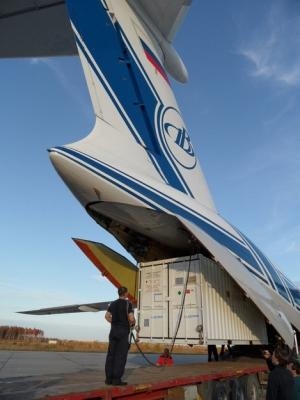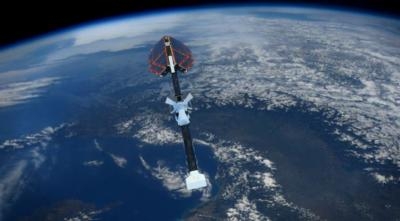Spacecraft Key To ESA's Mission To Study The Earth's Magnetic Field
The first of the three Astrium-built Swarm research satellites is on its way to the Plesetsk Cosmodrome. An Ilyushin-76, headed for Russia, took off from Munich Airport this morning. The remaining two satellites, plus the test and installation equipment, will follow at two-day intervals, amounting to a total of 63 metric tons of freight. The trio of satellites will be launched simultaneously from Plesetsk ... around 500 miles northeast of Moscow ... on a single Rockot launch vehicle in November 2013.

Astrium is the European Space Agency's (ESA) prime contractor for the Swarm mission. The purpose of the Swarm mission is to analyse, in unprecedented detail, the geomagnetic field and its evolution. The findings will help improve our understanding of the Earth's inner workings and its interaction with the space environment.
The three identical Swarm satellites will be launched into a polar orbit at an altitude of just over 300 miles and will carry out what is believed to be the most accurate survey to date of the Earth's magnetic field and its changes. Swarm will, in a manner of speaking, follow in the footsteps of Jules Verne’s novel "Journey to the Center of the Earth". Today, however, it is not always necessary to dig or drill to take a closer look at the composition and workings of the Earth’s interior. Thanks to the development of ‘satellite remote sensing’, Swarm can achieve this goal from orbit. The Earth’s gravitational and magnetic fields offer direct insights into the workings of its interior: from the variations these fields display at different times and places, scientists can draw conclusions about the dynamic processes taking place deep beneath the planet’s surface, in the outer core.
Extremely accurate, high-resolution readings of the geomagnetic field’s strength, orientation and fluctuations, complemented by precise navigation and velocity data, along with measurements of the electric field intensity, will provide the observational data required to distinguish between the various sources of the geomagnetic field and to explain them through models. Observation of these aspects from space offers a unique opportunity to take a closer look both at the composition of the interior of our planet and at the processes at work there. The mission will also enable scientists to analyze the Sun’s influence on the Earth. In addition, improvements in our knowledge of the geomagnetic field are expected to provide benefits of a practical nature, such as more accurate navigation for ships and aircraft, the discovery and access to natural resources below the Earth’s surface, improved global weather forecasting, and timely warnings of dangerous solar radiation.

Astrium began developing its first satellite for magnetic field research in deep space – the ISEE-B – back in the late 1970s. This work has continued with the development of the four-satellite Cluster constellation which has been in orbit and operating since 2000. In the field of low Earth orbit satellites, the German Champ satellite, which collected data from 2000 to 2010, was built to an Astrium design. The Swarm constellation is now the logical next step down this path. In terms of technology, Swarm has benefited from the legacy of both the Champ satellite and Cryosat, the polar ice research satellite – both projects led by Astrium. When it comes to overall system design, individual subsystems and test ranges, Astrium’s satellite builders can draw on the wealth of experience they gained in these earlier projects.
Swarm is the 'Three-satellite-mission' in ESA's 'Living Planet' program. Its mission is to study the Earth’s magnetic field. In its role as industrial prime contractor, Astrium (Friedrichshafen) is responsible for developing and building the Swarm satellites. Astrium is also actively involved in developing other satellites for ESA’s Earth Explorer missions. The company is the prime contractor for the EarthCARE Earth observation satellite which is currently under construction and for the ADM-Aeolus wind mission. Furthermore, Astrium built the Cryosat-2 ice research satellite, which was launched on 8 April 2010. Astrium also supplied the platform for GOCE, which has been successfully ‘surfing’ and measuring the Earth’s gravitational field since 17 March 2009. Astrium also developed and built the Miras payload for the SMOS mission for the observation of soil moisture and salinity over the oceans, which was launched on 2 November 2009.
(ESA Images: Top, Swarm satellite unloaded in Plesetsk. Bottom, Swarm in orbit from ESA animation video)
 Airbus Racer Helicopter Demonstrator First Flight Part of Clean Sky 2 Initiative
Airbus Racer Helicopter Demonstrator First Flight Part of Clean Sky 2 Initiative Diamond's Electric DA40 Finds Fans at Dübendorf
Diamond's Electric DA40 Finds Fans at Dübendorf ANN's Daily Aero-Term (04.23.24): Line Up And Wait (LUAW)
ANN's Daily Aero-Term (04.23.24): Line Up And Wait (LUAW) NTSB Final Report: Extra Flugzeugbau GMBH EA300/L
NTSB Final Report: Extra Flugzeugbau GMBH EA300/L Classic Aero-TV: 'Never Give Up' - Advice From Two of FedEx's Female Captains
Classic Aero-TV: 'Never Give Up' - Advice From Two of FedEx's Female Captains




